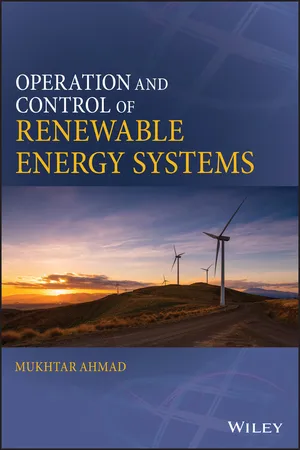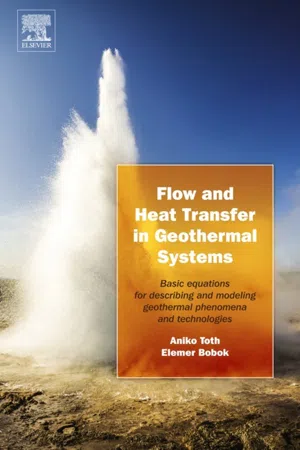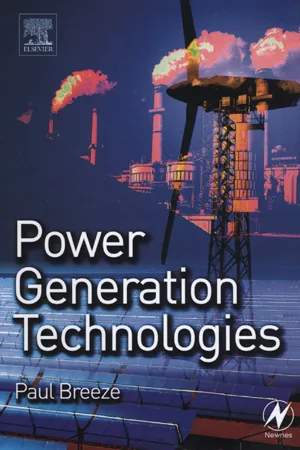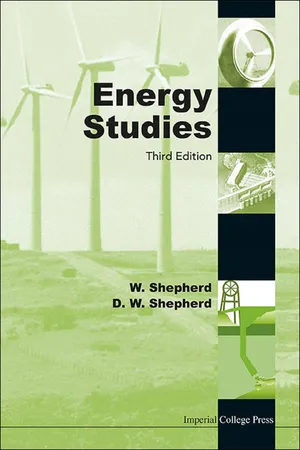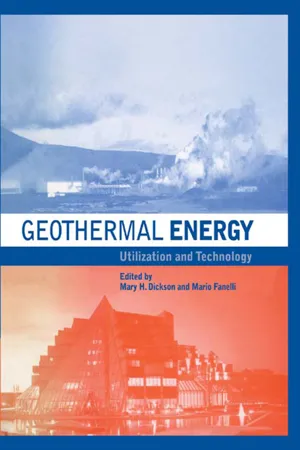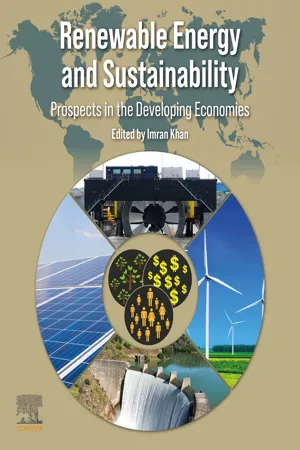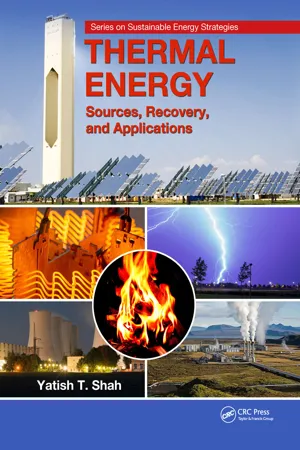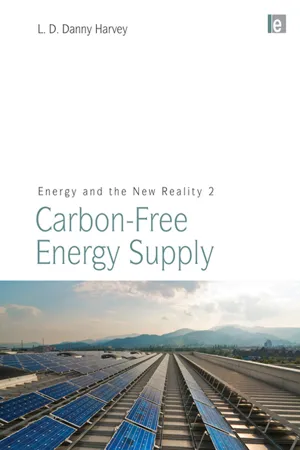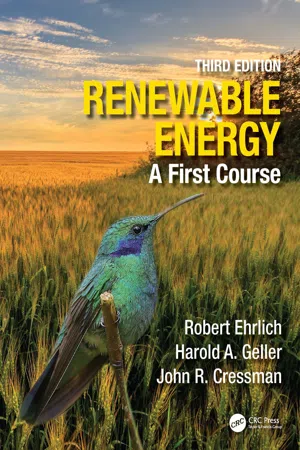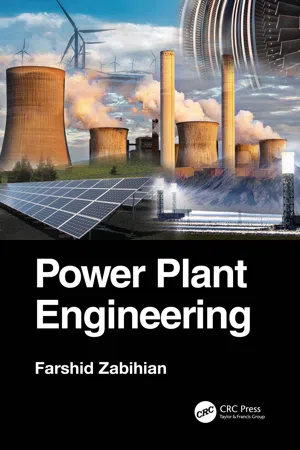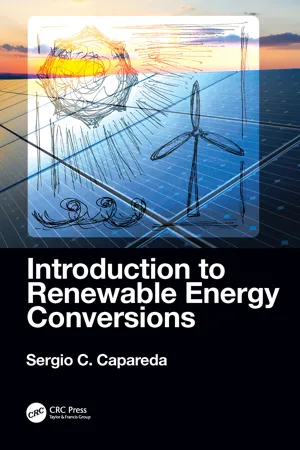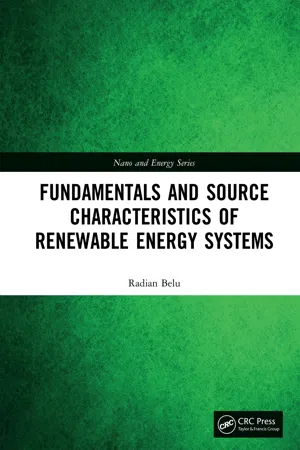Physics
Geothermal Energy
Geothermal energy is heat derived from the Earth's core, which can be harnessed for power generation and heating. This renewable energy source is obtained by tapping into hot water and steam reservoirs beneath the Earth's surface. Geothermal power plants use this heat to produce electricity, making it a sustainable and environmentally friendly energy option.
Written by Perlego with AI-assistance
Related key terms
12 Key excerpts on "Geothermal Energy"
- Mukhtar Ahmad(Author)
- 2017(Publication Date)
- Wiley(Publisher)
Chapter 9 Geothermal Energy9.1 The Origin of Geothermal Energy
The Geothermal Energy is basically thermal energy stored in the Earth's crust. It is clean and sustainable. It is one of the less-recognized forms of renewable energy, and this is the only form of renewable energy which is not dependent on the Sun. Geothermal Energy comes from the natural generation of heat primarily due to the decay of the naturally occurring radioactive isotopes of uranium, thorium and potassium within the Earth. Resources of Geothermal Energy range from the shallow ground to hot water and hot rock found a few miles beneath the Earth's surface and even deeper down to the extremely high temperatures of molten rock called magma. It is estimated that the annual energy due to the internal heat generation and flowing from the interior of the Earth to the surface is about 1021 J per year.Geothermal Energy has been used by the Romans, Japanese, Turks, Icelanders, Central Europeans and the Maori of New Zealand for bathing, cooking and space heating. Baths in the Roman Empire, the middle kingdom of the Chinese and the Turkish baths of the Ottomans were some of the early users of Geothermal Energy [1, 2].Geothermal Energy is present everywhere below the Earth's surface, but the most desirable resources are concentrated in the regions of active or geologically young volcanoes. Most geothermal reservoirs are deep underground with no visible sign of it available on the Earth's surface. But sometimes, Geothermal Energy erupts to the surface in the form of- volcanoes
- hot springs
- geysers.
The total thermal energy contained in the Earth is estimated to be 12.6 × 1012 EJ and that of the crust of the order of 5.4 × 109 EJ up to depths of 50 km. Stored thermal energy down to 3 km depth in the continents is estimated to be 42.67 × 106- eBook - ePub
Flow and Heat Transfer in Geothermal Systems
Basic Equations for Describing and Modeling Geothermal Phenomena and Technologies
- Aniko Toth, Elemer Bobok(Authors)
- 2016(Publication Date)
- Elsevier(Publisher)
Chapter 1What Is Geothermal Energy?
Abstract
The knowledge and use of Geothermal Energy have a long history. The primary source of Geothermal Energy is the decay of radioactive elements. This energy is stored in the high temperature region of the Earth's crust, mantle, and core. From an engineering point of view, only the upper region of the crust has practical importance. Terrestrial heat-flow and geothermal gradient are the main parameters used to characterize a region's geothermal properties. These parameters correspond to the tectonic motion of the lithosphere plates. That geothermal phenomenon occurs most intensely at the boundaries of the lithosphere plates. Where subcrustal erosion and tension stresses have thinned the continental crust terrestrial heat-flow is also above average. A geothermal reservoir is that part of the Earth's crust from which internal energy content can be recovered with the help of some reservoir fluid: steam, hot water, or a mixture of both. When studying geothermal reservoirs, different reservoir types yield correspondingly different conceptual models.Keywords
EGS; Geothermal gradient; Geothermal reservoir; HDR; Heat conduction; History of geothermal use; Mantle flow; Plate tectonics; Terrestrial heat-flowOutline1.1 Introduction 1.2 The Nature and Origin of Geothermal Energy 1.3 Geothermal Reservoirs References1.1. Introduction
Geothermal Energy is energy contained within the high temperature mass of the Earth's crust, mantle, and core. Since the Earth's interior is much hotter than its surface, energy flows continuously from the deep, hot interior up to the surface. This is the so-called terrestrial heat-flow. The temperature of the Earth's crust increases with depth in accordance with Fourier's law of heat conduction. Thus the energy content of a unit of mass also increases with depth.All of the Earth's crust contains Geothermal Energy, but Geothermal Energy can only be recovered by means of a suitable energy-bearing medium. To be practical, the energy-bearing media must be: hot enough (high-specific energy content), abundant enough, easily recoverable, inexpensive, manageable, and safe. Water satisfies these requirements perfectly. The specific heat of water is 4.187 - eBook - ePub
- Paul Breeze(Author)
- 2005(Publication Date)
- Newnes(Publisher)
12 Geothermal power Publisher Summary This chapter discusses Geothermal Energy, geothermal fields, and power plants such as direct-steam power plant, binary power plants, and flash-steam plants. Geothermal Energy is attractive for power generation because it is simple and relatively cheap to exploit. In the simplest case, steam can be extracted from a borehole and used directly to drive a steam turbine. There are three principle types of geothermal resource. A source of hot underground water is the simplest to exploit, which either reaches the surface naturally or can be tapped by drilling boreholes. Geothermal fields are formed when water from rain or snow is able to seep through faults and cracks within rock—sometimes for several kilometers—to reach hot rock beneath the surface. As the water is heated, it rises naturally back towards the surface by a process of convection and may appear there in the form of hot springs, geysers, fumaroles, or hot mud holes. The chapter presents the three principles ways of converting Geothermal Energy into electricity. Each is designed to exploit a specific type of geothermal resource. Geothermal Energy is the heat contained within the body of the earth. The origins of this heat are found in the formation of the earth from the consolidation of stellar gas and dust some 4 billion years ago. Radioactive decay within the earth continually generates additional heat which augments that already present. The distance from the surface of the earth to its core is 6500 km. Here the temperature may be as high as 7000°C. As a result of the temperature gradient between the centre and the much cooler outer regions, heat flows continuously towards the surface. An estimated 100 × 10 15 W of energy reaches the surface each year. Most of this heat cannot be exploited but in some places a geothermal anomaly creates a region of high temperature close to the surface - eBook - ePub
- W Shepherd, D W Shepherd(Authors)
- 2014(Publication Date)
- ICP(Publisher)
CHAPTER 7
Geothermal Energy
7.1.Physical Basis of Geothermal Energy
Geothermal Energy is thermal energy stored in the sub-surface of the earth. It is not a renewable source because prolonged exploitation can exhaust a particular site. Nevertheless, the vast extent of energy potentially available is such that many references refer to it as if it was infinitely renewable. Energy is stored in natural underground reservoirs of steam and/or hot water, known as aquifers, and also in more solid “hot sediments” that are buried at depth or adjacent to hot spots.Heat energy flows outwards from within the earth at the average rate of 0.063W/m2 . The total outward flow amounts to 32 × 1012 W, as shown in Fig. 2.1 of Chapter 2 . It is of interest that the amount of interior heat flux flowing outwards is only about one-thousandth the value of the solar energy flux falling from space onto the same area [1 , 2 ]. The surface geothermal heat distribution is too small and too diffuse to be exploited, except in concentrated hot spots such as geysers or volcanoes.7.2.Geological Structure of the Earth
The geological structure of the earth is illustrated in Fig. 7.1 [3 ]. It is believed to approximate to five concentric spheres. From the outside proceeding inwards these are the atmosphere, crust, mantle, liquid outer core (magma) and solid inner core. As one proceeds inwards the temperature and density increase. For non-volcanic (i.e. non-seismic) areas the average geothermal gradient is between 17°C and 30°C per kilometre of depth (50°−87°F per mile). In volcanic areas the temperature gradient is much higher.The earth’s crust, composed of basalt, silicate rocks, is not of uniform thickness. Under the oceans the crust is about 15 km thick and consists of porous rock. Under the continental land masses the crust is about 35 km thick (Fig. 7.2 ) and the proportion of porous rock probably increases with depth. Between the continental land mass and the ocean, the continental shelf contains a great thickness of sedimentary rocks such as sandstone or limestone [4 - eBook - ePub
Geothermal Energy
Utilization and Technology
- Mary H. Dickson, Mario Fanelli(Authors)
- 2013(Publication Date)
- Routledge(Publisher)
2. define geothermal systems and explain how they function3. define the main categories of Geothermal Energy4. discuss the present status of the development of Geothermal Energy in the world5. discuss the main research methods used in areas of potential geothermal interest6. discuss the major forms of geothermal utilization7. discuss the potential impact on the environment of Geothermal Energy.1.1 INTRODUCTIONHeat is a form of energy, and Geothermal Energy is literally the heat contained within the Earth that generates geological phenomena on a planetary scale. Geothermal Energy is often used nowadays, however, to indicate that part of the Earth’s heat that can, or could, be recovered and exploited by humankind, and it is in this sense that we will use the term from now on.1.1.1 Brief geothermal historyThe presence of volcanoes, hot springs and other thermal phenomena must have led our ancestors to surmise that parts of the interior of the Earth were hot. However, it was not until a period between the sixteenth and seventeenth century, when the first mines were excavated to a few hundred metres below ground level, that humankind deduced, from simple physical sensations, that the Earth’s temperature increased with depth.Figure 1.1The Earth’s crust, mantle and core. Top right: a section through the crust and the uppermost mantleThe first measurements by thermometer were probably performed in 1740, in a mine near Belfort, in France (Bullard, 1965). By 1870 modern scientific methods were being used to study the thermal regime of the Earth, but it was not until the twentieth century, and the discovery of the role played by radiogenic heat, that we could fully comprehend such phenomena as heat balance and the Earth’s thermal history. All modern thermal models of the Earth, in fact, must take into account the heat continually generated by the decay of the long-lived radioactive isotopes of uranium (U238 , U235 ), thorium (Th232 ) and potassium (K40 - eBook - ePub
Renewable Energy and Sustainability
Prospects in the Developing Economies
- Imran Khan(Author)
- 2022(Publication Date)
- Elsevier(Publisher)
Chapter 9Geothermal Energy in developing countries–The dilemma between renewable and nonrenewable
Nurdan Yildirima , Emin Selahattin Umduba Mechanical Engineering Department, Yasar University, Bornova, İzmir-Turkeyb Energy Systems Engineering Department, Yasar University, Bornova, İzmir-Turkey9.1 Introduction
The word geothermal is formed by the combination of the Greek words geo (earth) and therme (heat). Basically, Geothermal Energy, resulting from the molten interior of the earth and the decay of radioactive materials in underground rocks, is generally defined as the energy coming from the depths of the earth. The temperature at the center of the Earth, around 6500 km-depth, is about 6000°C and is almost the same as the surface temperature of the sun. Magma, rising in places on the buoyancy forces, pushes the plates towards the Earth's crust and in this way a large amount of heat has been emitted from the Earth's core for about 4.5 billion years. The temperature gradient of the Earth and the total heat flux from the Earth's interior are normally 2 to 3°C/100 m and around 80 mWth/m2 , respectively (Dumas, 2017 ). Since the radioactive processes in the core of the Earth are continuous, Geothermal Energy can be classified as a renewable energy source (G. Systems, 2016 ; Yildirim, 2010 ; Petroski, 2013 ; Miller, 2006 ).Rainwater and melted snow seepage into the ground with the help of faults and cracks in the earth, and then they are heated up to above boiling temperature such as 260°C or more by hot rocks (Nemzer, 2005 ). If hot rocks are permeable, the percolating surface waters naturally circulate back to the surface, returned as steam forming hot springs, geysers, and fumaroles. When the rocks are not permeable, the water is trapped by impermeable rocks, filling the rock pores and cracks, geothermal reservoir is formed (Burgess, 1989 - eBook - ePub
Thermal Energy
Sources, Recovery, and Applications
- Yatish T. Shah(Author)
- 2018(Publication Date)
- CRC Press(Publisher)
3 Geothermal Heat 3.1 INTRODUCTIONAs mentioned in Chapter 1 , there are three types of thermal energy sources: natural, synthetic (or man-made), and benign (or residual). Geothermal and solar energy are the natural sources of thermal energy. Nuclear (fission process), combustion (chemical process), and electrical heating are synthetic or man-made sources of thermal energy. Finally, waste and stored heat are benign or residual sources of thermal energy. In the next two chapters, we first address natural sources of thermal energy.Geothermal Energy is the energy contained as heat in the Earth’s interior [1 ,2 ,3 ,4 ,5 ,6 ,7 ,8 ,9 ,10 ,11 ,12 ]. The origin of this heat is linked with the internal structure of our planet and the physical processes occurring there. Despite the fact that this heat is present in huge, practically inexhaustible quantities in the Earth’s crust, not to mention the deeper parts of our planet, it is unevenly distributed, seldom concentrated, and often at depths too great to be exploited industrially. Scientists believe that “the ultimate source of Geothermal Energy is radioactive decay occurring deep within the earth,” as well as the natural magma pockets deep under the surface [8 ,11 ]. This heat is held within the surrounding rock and transferred throughout the Earth’s crust through fractures and pores bearing natural fluids such as water or superheated vapor.The heat moves from the Earth’s interior towards the surface where it dissipates, although this fact is generally not noticed. We are aware of its existence because the temperature of rocks increases with depth, proving that a geothermal gradient exists: this gradient averages 30°C/km of depth. There are, however, areas of the Earth’s crust which are accessible by drilling, and where the gradient is well above the average. This occurs when, not far from the surface (a few kilometers) there are magma bodies undergoing cooling, still in a fluid state or in the process of solidification, and releasing heat. In other areas, where magmatic activity does not exist, the heat accumulation is due to particular geological conditions of the crust such that the geothermal gradient reaches anomalously high values. Although, as mentioned earlier, the average gradient near the surface, say within a few kilometers, is about 30°C/km, but values as low as about 10°C/km are found in ancient continental crust, and very high values (100°C/km) are found in areas of active volcanoes. Once the gradient has been measured, it can be used to determine the rate at which heat is moving upwards through a particular part of the Earth’s crust [1 ,2 ,3 ,4 ,5 ,6 ,7 ,8 ,9 ,10 ,11 - eBook - ePub
Energy and the New Reality 2
Carbon-free Energy Supply
- L. D. Danny Harvey(Author)
- 2010(Publication Date)
- Routledge(Publisher)
5 Geothermal Energy 5.1 IntroductionHeat flows outward from the interior of the earth due to the fact that the temperature at the centre of the earth is around 7000°C. This heat is partly left over from the formation of the earth about 4.6 billion years ago, and partly a result of heat released from the radioactive decay of long-lived radioactive isotopes, principally thorium-232, uranium-238 and potassium-40. The average geothermal heat flux is about 0.06W/m2 under the continents and 0.10W/m2 under the oceans (Barbier, 2002). This heat flux is equal to the vertical temperature gradient times the thermal conductivity. Given a thermal conductivity of crustal rocks of 2.5–3.5W/m/K, this implies a typical vertical temperature gradient under continents of about 15–20K/km. Mudrocks (clays and shales) have a smaller thermal conductivity of (1–2W/m/K), resulting in a more rapid increase of temperature with depth for a given geothermal heat flux. Under most of the densely populated parts of the continents, the geothermal heat flux is less than 0.05W/m2 . A few regions attain heat fluxes of 0.1W/m2 . In local volcanic regions where molten or partially molten rocks occur within a few kilometres of the surface (and at temperatures of up to 1000°C), much larger heat fluxes can be found. At present, Geothermal Energy supplies only a small fraction of the world’s energy needs – about 0.12 per cent of global electricity generation and 0.6 per cent of global residential and commercial space heating and hot water requirements.5.2 Geothermal Resources Geothermal Energy occurs in several different useful forms, which are described here. 5.2.1 HydrothermalHydrothermal resources consist of steam or liquid water at temperatures of up to 500°C at a depth of up to 4km in permeable rock.1 Three conditions are required for the formation of hydrothermal resources: an aquifer (a porous and permeable layer of rock filled with water), an overlying impermeable layer and a heat source. The relationships between these ingredients and surface features are shown in Figure 5.1 - eBook - ePub
Renewable Energy
A First Course
- Robert Ehrlich, Harold A. Geller, John R. Cressman(Authors)
- 2022(Publication Date)
- CRC Press(Publisher)
In fact, on average, only around 0.06 ± 0.02 W/m 2 geothermal power reaches the Earth’s surface on its own, which is a tiny fraction of the energy reaching the surface from the sun. However, the available stored thermal energy in the Earth’s interior is enormous. According to an MIT study, the US total Geothermal Energy that could feasibly be extracted with improved technology in the upper 10 km of the Earth’s crust is over 2,000 ZJ or 2 × 10 24 J or 4,000 times the energy humans use per year (Tester, 2006). Heat is created underground by at least six different mechanisms, but around 80% of it is generated due to radioactive decay mostly from very long-lived isotopes of uranium and thorium—although that estimated 80% could be as little as 45% or as much as 90%. Given that decay of radioisotopes having multibillion-year half-life is the primary source of the Earth’s heat, even if it were extracted in sizable quantities, there need be no concern of it running out, since it is being continually replenished. 6.1.4 Comparison with Other Energy Sources Geothermal Energy as a means of generating electricity has the great advantage of not being intermittent like most other renewable sources, such as wind and solar; in fact, its average capacity factor is around 73%. This means that a plant produces full power 73% of the time—far higher than wind turbines, for example. As a result, geothermal electrical plants are capable of providing base load electricity, which is not the case for intermittent renewable sources such as wind. Moreover, in places where conditions are favorable, geothermal electric power can be produced at a very cost-competitive basis compared to other methods, either renewable or nonrenewable. As with other forms of renewable energy, the cost of electricity from an existing plant does not fluctuate like the price of gas or oil does, since the fuel is free - eBook - ePub
- Farshid Zabihian(Author)
- 2021(Publication Date)
- CRC Press(Publisher)
15Geothermal Energy
AbstractWe will first learn about the origin of Earth, its different inners layers and their characteristics, and the sources of its energy. We will then discuss how Geothermal Energy can be assessed. We will take a look at Geothermal Energy applications, particularly for heating purposes either directly or via heat pumps. Next, we will briefly review the history of Geothermal Energy utilizations and their current status. We will discuss different types of geothermal resources and their characteristics. Then, we will learn about various methods employed to find geothermal resources followed by a discussion on the drilling process to access Geothermal Energy resources and equipment used for this purpose. Next, we will study how Geothermal Energy is converted to electricity in power generation units. We will discuss about vapor-dominated, liquid-dominated, and binary cycles. Finally, we will learn about enhanced or engineered geothermal systems (EGS). We will conclude the chapter with a brief review of the environmental impacts of Geothermal Energy systems.Learning Outcomes
After successful completion of this chapter, you will be able to- explain the origin of Earth, its inner structure, and its energy
- describe the application of Geothermal Energy for heating purposes either directly or via heat pumps
- characterize geothermal resources
- identify various methods used in the exploration of geothermal resources
- describe drilling methods and equipment to access geothermal resources
- explain different types of power generation units for the conversion of Geothermal Energy to electricity (vapor-dominated, liquid-dominated, and binary cycles)
- explain enhanced or engineered geothermal systems (EGSs)
- identify the environmental effects of geothermal power generation systems
15.1 Introduction
Geothermal Energy is a source of thermal energy provided by the inner core of Earth. Unlike most other energy sources, particularly renewable energy sources, this energy is not originated from the Sun. This characteristic of Geothermal Energy provides a unique advantage for geothermal-based energy systems that other renewable energy systems may find hard to compete. Geothermal Energy sources are not intermittent, and unlike many other renewable energy sources, they do not suffer from daily, seasonal, and unpredictable variations. They are available around the clock all year. As a result, they can be used as baseload power generation units with a capacity factor of typically between 70% and 90%. - eBook - ePub
- Sergio Capareda(Author)
- 2019(Publication Date)
- CRC Press(Publisher)
Figure 6.1 . Japan, the Philippines, and Indonesia lie along this area, and the ring also borders the United States. These countries have already tapped into geothermal power potential and are currently generating a considerable amount of energy from the resource. Technically speaking, it is tricky to classify Geothermal Energy as renewable because it concerns the cooling of the earth, which in itself not a reversible process. There is no way to replenish Geothermal Energy once it is used. However, energy is continually produced from the decay of naturally radioactive materials, such as uranium and potassium. Solar energy is a temporal resource and cannot be used for this purpose. The amount of energy currently being removed is very small compared to the magnitude of geothermal resources available. At least for practical purposes, Geothermal Energy may be considered a renewable energy resource.6.2 Temperature Profile in Earth's Core
Geothermal Energy can be harnessed because the temperature profile of the earth increases as one goes deeper into its core. The temperature profile is illustrated in Figure 6.2 . In this figure, the earth is divided into three zones: the mantle, the outer core, and the inner core. The mantle is some 2,900 km [1,802.4 mi] below the earth's crust, while the outer core is around 5,100 km [3,169.7 mi] from the crust. The inner core is some 6,378 km [3,964 mi] from the earth's crust, which is close to 100 km [62.15 mi] in thickness. The lithosphere is the area of the earth that is on the uppermost solid mantle, or the crust. At the bottom of this region, the temperature is approximately 1,750°C [3,182°F].Going deeper into the earth's core, the bottom of the mantle has an approximate temperature of about 3,090°C [5,594°F], and the top layer of the inner core has an estimated temperature of 4,250°C [7,682°F]. Currently these areas are not being tapped by Geothermal Energy systems since technology has not yet been developed for those purposes.The temperature profile of the earth surface is also variable depending upon the geologic nature of a site. Figure 6.3 shows some temperature profiles for three types of gradients. These are enumerated below:- Normal conductive gradient
- High conductive gradient
- Enhanced convective flow
A normal conductive gradient has temperature that varies linearly and reaches the boiling point of water (100°C) [212°F] at around 5 km [3.10 mi]. A high conductive gradient will have reached 100°C [212°F] in a little over 1 km [0.622 mi]. The enhanced convective flow is most ideal for geothermal systems, and such sites are usually found within the Ring of Fire. Planners of geothermal system projects have devised some means to evaluate whether a site has potential for geothermal applications. Planners typically conduct exploration surveys to evaluate a certain site. The specific activities used to identify geothermal potential in an area may be as follows: - Radian Belu(Author)
- 2019(Publication Date)
- CRC Press(Publisher)
Due to the steady heat flow from the inner parts of the Earth, geothermal resources can be regarded as renewable. A geothermal system can in many cases be recharged as a battery. Utilizing the natural flow from geothermal springs does not affect them. Exploitation through drilled wells and by them application of down-hole pumps always leads to some physical or chemical changes in the reservoir and/or its near vicinity, which could lead to a reduction or depletion of geothermal resources so far as a particular utility is concerned. Geothermal Energy has a high availability and capacity factor of about 80%–90%. In comparison with wind, solar and tidal energy, geothermal is clearly an advanced energy source with 61% of the total installed capacity and 86% of the renewable electricity production in recent years. The relatively high share in the electricity production reflects them reliability of geothermal plants. The generation reliability also demonstrates one of the strongest comparative points of Geothermal Energy. Unlike solar energy, geothermal is available day and night throughout the year and is not dependent on climatic conditions like in the case of wind energy. Geothermal Energy is a powerful natural resource with the potential to shape the future of human society. It is relatively clean and environmentally friendly when compared to present energy sources such as fossil fuels. Its possible applications are numerous and its ubiquitous nature means that it is not limited to any physical location for extraction or use, especially given that methods are being developed to access non-ideal systems such as hot dry rock systems.Geothermal systems can be classified by a variety of criteria, such as the nature of heat transfer (conductive vs. convective), the presence or absence of recent magmatism or volcanic activity, the particular geologic setting (e.g., type of volcanic environment) or tectonic setting (e.g., type of plate boundary or intra-plate geologic hot spot), and, of course, temperature (low-, moderate-, and high-enthalpy systems). Other criteria include fluid chemistry, such as acidic or near pH-neutral systems; vapor- vs. liquid-dominated systems; and how the system is used (power, direct use, or geo-exchange). It is not uncommon for the different classifications to overlap. Ultimately, the classification of any geothermal system is based on study, playing a significant role in how that system is developed. For example, a liquid-dominated system, based on temperature and mass flow rate confirmed by drilling, can be used for flash or binary power generation, combined power and heat, or direct use, whereas, the rare vapor-dominated systems are used for power generation, being the most economic and efficient resource use. Although power generation captures much of the attention of the Geothermal Energy field, direct-use is much more widely applied as sub-power generating temperatures of fluids are widespread and can be developed with less cost than power plants. Indeed, one of the important attributes of geothermal systems is their wide use range over a cascading range of temperatures. Even where no hot fluids or rocks are present, the Earth acts like a thermal bank, where heat can be stored during the summer and withdrawn during the winter. In regions characterized by hot summers and cold winters, geo-exchange systems can significantly reduce energy consumption using conventional fossil fuel sources.
Index pages curate the most relevant extracts from our library of academic textbooks. They’ve been created using an in-house natural language model (NLM), each adding context and meaning to key research topics.
